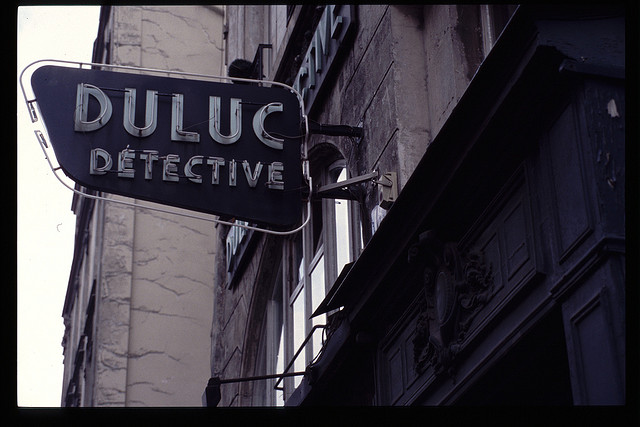More Practice

"Duluc Detective," photo by Pete Reed
First, read the following excerpt about "private eye" detective novels from Wikipedia.
Martin Hewitt, created by British author Arthur Morrison in 1894, is perhaps the first example of the modern style of fictional private detective.
By the late 1920s, Al Capone and the Mob were inspiring not only fear, but piquing mainstream curiosity about the American underworld. Popular pulp fiction magazines like Black Mask capitalized on this, as authors such as Carrol John Daly published violent stories that focused on the mayhem and injustice surrounding the criminals, not the circumstances behind the crime. From within this literary environment emerged many stories and novels about private detectives, also known as private investigators, PIs and "private eyes" ("eye" being the vocalization of "I" for "investigator"). Very often, no actual mystery even existed: the books simply revolved around justice being served to those who deserved harsh treatment, which was described in explicit detail."
In the 1930s, the private eye genre was adopted wholeheartedly by American writers. The tough, stylish detective fiction of Dashiell Hammett, Jonathan Latimer, Erle Stanley Gardner and others explored the "mean streets" and corrupt underbelly of the United States. Their style of crime fiction came to be known as "hardboiled", which encompasses stories with similar attitudes concentrating not on detectives but gangsters, crooks, and other committers or victims of crimes. "Told in stark and sometimes elegant language through the unemotional eyes of new hero-detectives, these stories were an American phenomenon."
In the late 1930s, Raymond Chandler updated the form with his private detective Philip Marlowe, who brought a more intimate voice to the detective than the more distanced, "operatives report" style of Hammett's Continental Op stories. Despite struggling through the task of plotting a story, his cadenced dialogue and cryptic narrations were musical, evoking the dark alleys and tough thugs, rich women and powerful men about whom he wrote. Several feature and television movies have been made about the Philip Marlowe character. James Hadley Chase wrote a few novels with private eyes as the main hero, including Blonde's Requiem (1945), Lay Her Among the Lilies (1950), and Figure It Out for Yourself (1950). Heroes of these novels are typical private eyes very similar to Philip Marlowe.
Ross Macdonald, pseudonym of Kenneth Millar, updated the form again with his detective Lew Archer. Archer, like Hammett's fictional heroes, was a camera eye, with hardly any known past. "Turn Archer sideways, and he disappears," one reviewer wrote. Two of Macdonald's strengths were his use of psychology and his beautiful prose, which was full of imagery. Like other 'hardboiled' writers, Macdonald aimed to give an impression of realism in his work through violence, sex and confrontation; this is illusory, however, and any real private eye undergoing a typical fictional investigation would soon be dead or incapacitated. The 1966 movie Harper starring Paul Newman was based on the first Lew Archer story The Moving Target (1949). Newman reprised the role in The Drowning Pool in 1976.
Michael Collins, pseudonym of Dennis Lynds, is generally considered the author who led the form into the Modern Age. His PI, Dan Fortune, was consistently involved in the same sort of David-and-Goliath stories that Hammett, Chandler, and Macdonald wrote, but Collins took a sociological bent, exploring the meaning of his characters' places in society and the impact society had on people. Full of commentary and clipped prose, his books were more intimate than those of his predecessors, dramatizing that crime can happen in one's own living room.
The PI novel was a male-dominated field in which female authors seldom found publication until Marcia Muller, Sara Paretsky, and Sue Grafton were finally published in the late 1970s and early 1980s. Each author's detective, also female, was brainy and physical and could hold her own. Their acceptance, and success, caused publishers to seek out other female authors.
from "Detective Fiction." Wikipedia: The Free Encyclopedia. Wikimedia Foundation, Inc. 22 July 2004. Web. 06 Jan. 2014
Next, complete the following practice.
| Click the card deck to view a card. Drag the card from the bottom to the correct category. | |||
|
|||
After finishing this lesson, complete the form below:


